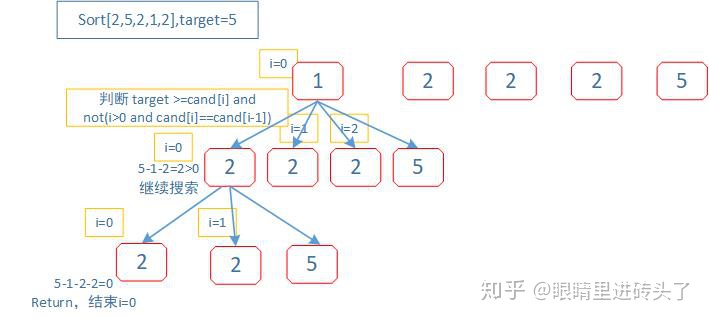
回溯法,又称深度优先搜索,Deepth-First-Search; 先递归下去,至最深一层,从最深层次开始遍历回溯至第一层;
还有一个叫做广度优先搜索(BFS),先压着不在这阐述了。
既然叫做回溯法,那肯定是步骤中有回溯这一步,说起来简单,代码里是怎么递归至最深一层,然后又怎么回溯上来,两个大大的问号在我这个小菜鸡头上。
上几道题,直接题里找找感觉。
39.组合总和
39.组合总和 给定一个**无重复元素**的数组 candidates 和一个目标数 target , 找出 candidates 中所有可以使数字和为 target 的组合。candidates 中的数字可以无限制重复被选取。
说明: 所有数字(包括 target)都是正整数。解集不能包含重复的组合。
示例 1:
输入:candidates = [2,3,6,7], target = 7,
所求解集为: [ [7], [2,2,3] ]
示例 2:
输入:candidates = [2,3,5], target = 8,
所求解集为: [ [2,2,2,2], [2,3,3], [3,5] ]
class Solution:
def combinationSum(self, candidates, target):
'''
tag:回溯法,选取一个值(append),进行循环比较操作后,pop出去(回到上一步)
Python3 的 [1, 2] + [3] 语法生成了新的列表,一层一层传到根结点
以后,直接 res.append(path) 就可以了;
基本类型变量在传参的时候,是复制,因此变量值的变化在参数里体现就行,
所以 Python3 的代码看起来没有「回溯」这个步骤。
'''
def dfs(candidates, begin, size, path, res, target):
if target < 0:
return
if target == 0:
res.append(path)
return
for index in range(begin, size):
# path =path + [candidates[index]] //思想
# path[-1].pop() // (这一步实现需要更多的逻辑判断),直接融合到参数这体现更简洁
dfs(candidates, index, size, path + [candidates[index]], res, target - candidates[index])
size = len(candidates)
if size == 0:
return []
path = []
res = []
dfs(candidates, 0, size, path, res, target)
return res从数组的第一个点,开始挨个遍历,同时并判断target = target-sum大小,小于0,则回溯上一层,重复操作,附个图解释一下。逻辑思路
Analyze:
Func:
判断target:
等于0, res.append(path)
小于0,返回上一层
大于0:继续往下遍历
从第一个元素i=0 in (0,len)开始搜索:
path = path.append(cand[i])
设置 target = target - cand[i],回溯调Func
path.remove(cand[i])
再附一段JAVA,更清楚的体现了回溯这一步,看完JAVA的代码,小脑袋瓜一下子有了回溯的大体印象
// Java Code --Java更容易理清回溯法的逻辑
private void dfs(int[] candidates, int begin, int len, int target,
Deque<Integer> path, List<List<Integer>> res) {
// target 为负数和 0 的时候不再产生新的孩子结点
if (target < 0) {
return;
}
if (target == 0) {
res.add(new ArrayList<>(path));
return;
}
// 重点理解这里从 begin 开始搜索的语意
for (int i = begin; i < len; i++) {
path.addLast(candidates[i]);
// 注意:由于每一个元素可以重复使用,下一轮搜索的起点依然是 i,这里非常容易弄错
dfs(candidates, i, len, target - candidates[i], path, res);
// 状态重置
path.removeLast();
}
}40 数组总和II
给定一个数组 candidates 和一个目标数 target ,找出 candidates 中所有可以使数字和为 target 的组合。 candidates 中的每个数字在每个组合中只能使用一次。
说明: 所有数字(包括目标数)都是正整数。 解集不能包含重复的组合。
示例 1: 输入: candidates = [10,1,2,7,6,1,5], target = 8,
所求解集为: [ [1, 7], [1, 2, 5], [2, 6], [1, 1, 6] ]
示例 2: 输入: candidates = [2,5,2,1,2], target = 5,
所求解集为: [ [1,2,2], [5] ]
class Solution:
def combinationSum2(self, candidates: List[int], target: int) -> List[List[int]]:
'''这个题与上面不同,给的数组是包含重复数的,故会出现重复解,需去重。
'''
def dfs(cand, tar, path, res):
if tar <0:
return
if tar == 0:
res.append(path)
return
n = len(cand)
for i in range(n): # 排序完之后避免在同一层中使用相同的元素
# tar小于下一个数或(i不是第一个数且前后数相等)时,跳过不执行搜索句,其他条件都执行
if target >=cand[i] and not(i>0 and cand[i]==cand[i-1]):
# candidates[i+1:]从第i+1个数开始搜索
dfs(cand[i+1:], tar-cand[i], path+[cand[i]], res)
candidates.sort() # 先排序(因为需要比较前后一个值是否相同)
res,path = [], []
dfs(candidates,target, path, res)
return res这一题与上一题不同的点在于,这给的数组是包含重复数的,故会出现重复解,需去重。这里每个数字只能选一次,不能重复选。逻辑思路思考一下i的值。每次dfs回溯传进去的是cand[i+1:],表示每次都是从i=0开始搜索。

逻辑代码:
Analyze:
1.因为需要数字去重,故先排序
2.每次在选择下一个数字时,多进行一步逻辑判断target >=cand[i] and not(i>0 and cand[i]==cand[i-1]):
DFSFunc:
判断target:
等于0, res.append(path)
小于0,return (返回上一层)
大于0:继续往下遍历
从第一个元素i=0 in (0,len)开始搜索:
path = path.append(cand[i])
设置 target = target - cand[i],回溯调DFSFunc,此时每次传进来的数组为cand[i:](去重很关键,体会一下)
path.remove(cand[i])79. 单词搜索 【回溯】
给定一个二维网格和一个单词,找出该单词是否存在于网格中。
单词必须按照字母顺序,通过相邻的单元格内的字母构成,其中“相邻”单元格是那些 水平相邻或垂直相邻的单元格。同一个单元格内的字母不允许被重复使用。
示例: board = [ ['A','B','C','E'], ['S','F','C','S'], ['A','D','E','E'] ]
给定 word = "ABCCED", 返回 true
给定 word = "SEE", 返回 true
给定 word = "ABCB", 返回 false
提示: board 和 word 中只包含大写和小写英文字母。
class Solution:
# 建立一个网格,
def exist(self, board: List[List[str]], word: str) -> bool:
m = len(board) # row
n = len(board[0]) # column
visited = [[False] * n for _ in range(m)]
rows = [-1, 0, 1, 0]
cols = [0, 1, 0, -1] # 上下左右四个方向
def dfs(x, y, idx):
"""搜索单词
Args:
x: 行索引
y: 列索引
idx: 单词对应的字母索引
"""
if board[x][y] != word[idx]:
return False
if idx == len(word) - 1:
return True
# 先标记
visited[x][y] = True
# 找到符合的字母[x,y]处开始向四个方向扩散搜索
for i in range(4):
nx = x + rows[i]
ny = y + cols[i]
# 新的坐标nx,ny没有越界,且[nx][ny]没有被使用过且在board查找到word[idx+1](回溯在这里)
if 0 <= nx < m and 0 <= ny < n and not visited[nx][ny] and dfs(nx, ny, idx+1):
return True
# 扩散未搜索对应的字母,释放标记
# 继续往其他方位搜索
visited[x][y] = False
return False
for x in range(m):
for y in range(n):
if dfs(x, y, 0):
return True
return False逻辑思路
Analyze:
从给的board中挨个搜索,找到word中第一个字母word[0]在board中的位置:
if找到,则回溯:
(假设坐标[1,1,]):则在坐标[1,1]上下左右四方向依次搜寻下一个word[1]的位置(回溯含在搜寻条件中,主要是用于回溯上一个位置。
:比如坐标[1,1]上方board[1,2]==word[1],则继续在[1,2]位置往下寻找,否则回溯到[1,1]下方位继续搜寻)78.子集
【位运算+回溯】
给定一组不含重复元素的整数数组nums,返回该数组所有可能的子集(幂集)。
说明:解集不能包含重复的子集。
示例: 输入: nums = [1,2,3]
输出: [ [3], [1], [2], [1,2,3], [1,3], [2,3], [1,2], [] ]
class Solution:
# 方法一
def subsets(self, nums: List[int]) -> List[List[int]]:
res = [[]]
for i in nums:
res = res + [[i] + num for num in res]
return res
# 方法二
def subsets(self, nums: List[int]):
res = []
n = len(nums)
def helper(i, n, tmp):
res.append(tmp)
# print(f"{i},,{tmp},,{res}")
for j in range(i, n):
helper(j + 1, n, tmp + [nums[j]])
helper(0, n, [])
return res逻辑分析
这里的回溯指的是每次回到tmp=[]或tmp的上一个状态。
方法二:
Analyze: 这题直接把输出放出来,一下就看明白了
# 第一层循环helper(0,n,[]), j=0:
0,,[],,[[]]
1,,[1],,[[], [1]]
2,,[1, 2],,[[], [1], [1, 2]]
3,,[1, 2, 3],,[[], [1], [1, 2], [1, 2, 3]]
# 第一层中的第二层循环helper(0, n=2, [1]), j=1
3,,[1, 3],,[[], [1], [1, 2], [1, 2, 3], [1, 3]] # j=2, heper(2+1,2,[1,3])这里第二层循环结束
#第一层循环helper(0, n, []), j=1
2,,[2],,[[], [1], [1, 2], [1, 2, 3], [1, 3], [2]]
3,,[2, 3],,[[], [1], [1, 2], [1, 2, 3], [1, 3], [2], [2, 3]]
#第一层循环helper(0, n, []), j=2 (第一层循环结束)
3,,[3],,[[], [1], [1, 2], [1, 2, 3], [1, 3], [2], [2, 3], [3]]90.子集II
同样是不含重复子集,这一题与上一题不同的是给定数组包含重复元素
给定一个可能包含重复元素的整数数组 nums,
返回该数组所有可能的子集(幂集)。
说明:解集不能包含重复的子集。
示例: 输入: [1,2,2]
输出: [ [2], [1], [1,2,2], [2,2], [1,2], [] ] '''
class Solution:
def subsetsWithDup(self, nums):
if not nums:
return []
n = len(nums)
res = []
nums.sort()
# 思路1
def helper1(idx, n, temp_list):
if temp_list not in res: # 判断一下有没有,不够优雅
res.append(temp_list)
for i in range(idx, n):
helper1(i + 1, n, temp_list + [nums[i]])
# 思路2,这个思路是优雅的
def helper2(idx, n, temp_list):
res.append(temp_list)
for i in range(idx, n):
# 这个i>idx条件很重要,
if i > idx and nums[i] == nums[i - 1]:
continue
helper2(i + 1, n, temp_list + [nums[i]])
helper2(0, n, [])
return res分析: 当涉及到重复元素时,子集要求不重复,那必定是需要先排序,然后再比较前后位元素是否相同,重点就是在if条件判断,其他的思路就与上一题无差别了。
经过这几道题以及基本思想和套路总结,对回溯法有那么点感觉了,你上你也行!
后续持续更新,待续~







 本文介绍了回溯法的基本思想,将其与深度优先搜索(DFS)联系起来,并通过LeetCode的几道经典题目,如组合总和、数组总和II、单词搜索、子集及子集II,详细阐述了回溯法的递归过程和回溯操作。通过实例代码,帮助读者理解如何在解决含有重复元素的问题中应用回溯法。
本文介绍了回溯法的基本思想,将其与深度优先搜索(DFS)联系起来,并通过LeetCode的几道经典题目,如组合总和、数组总和II、单词搜索、子集及子集II,详细阐述了回溯法的递归过程和回溯操作。通过实例代码,帮助读者理解如何在解决含有重复元素的问题中应用回溯法。














 973
973

 被折叠的 条评论
为什么被折叠?
被折叠的 条评论
为什么被折叠?








